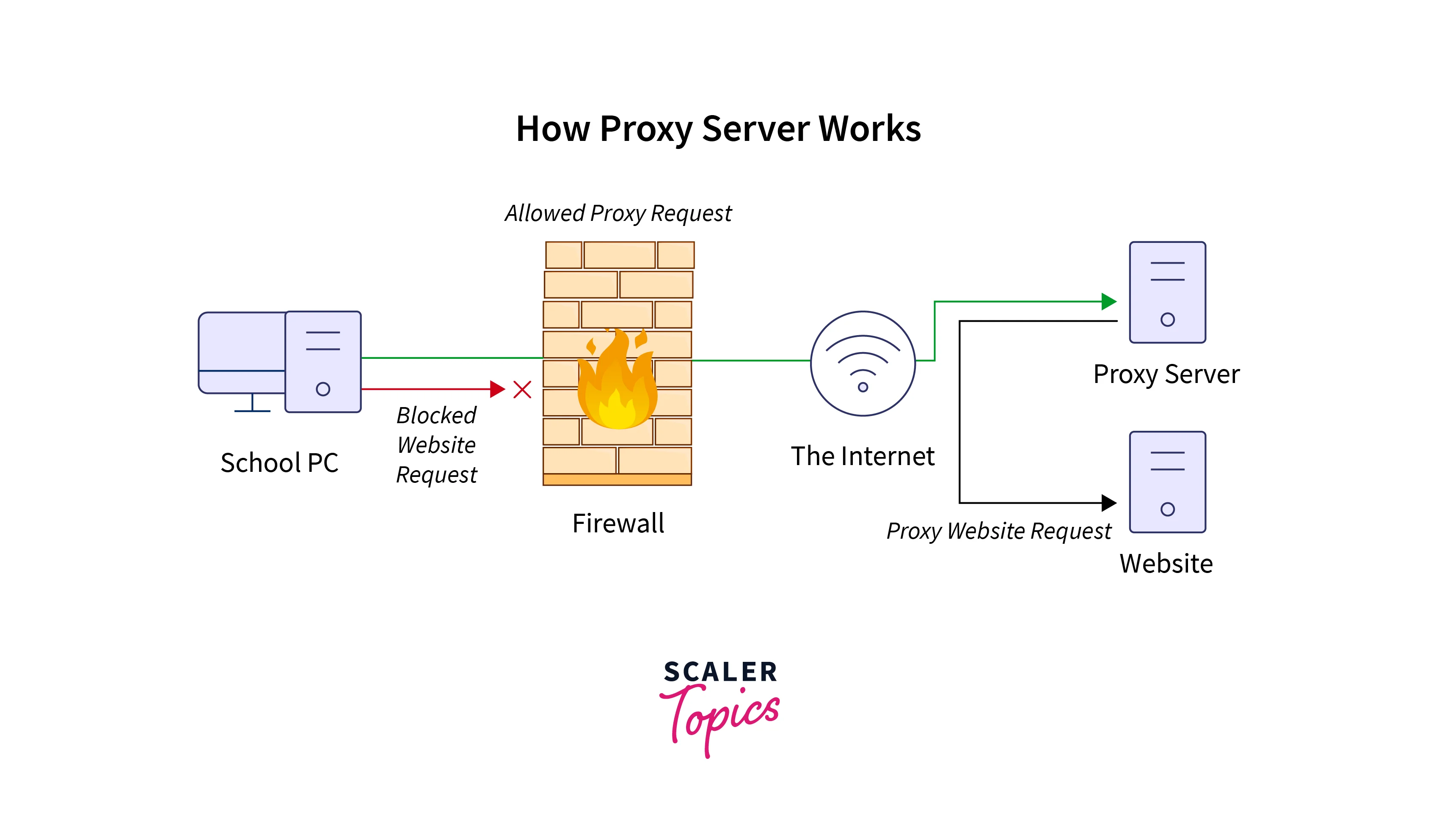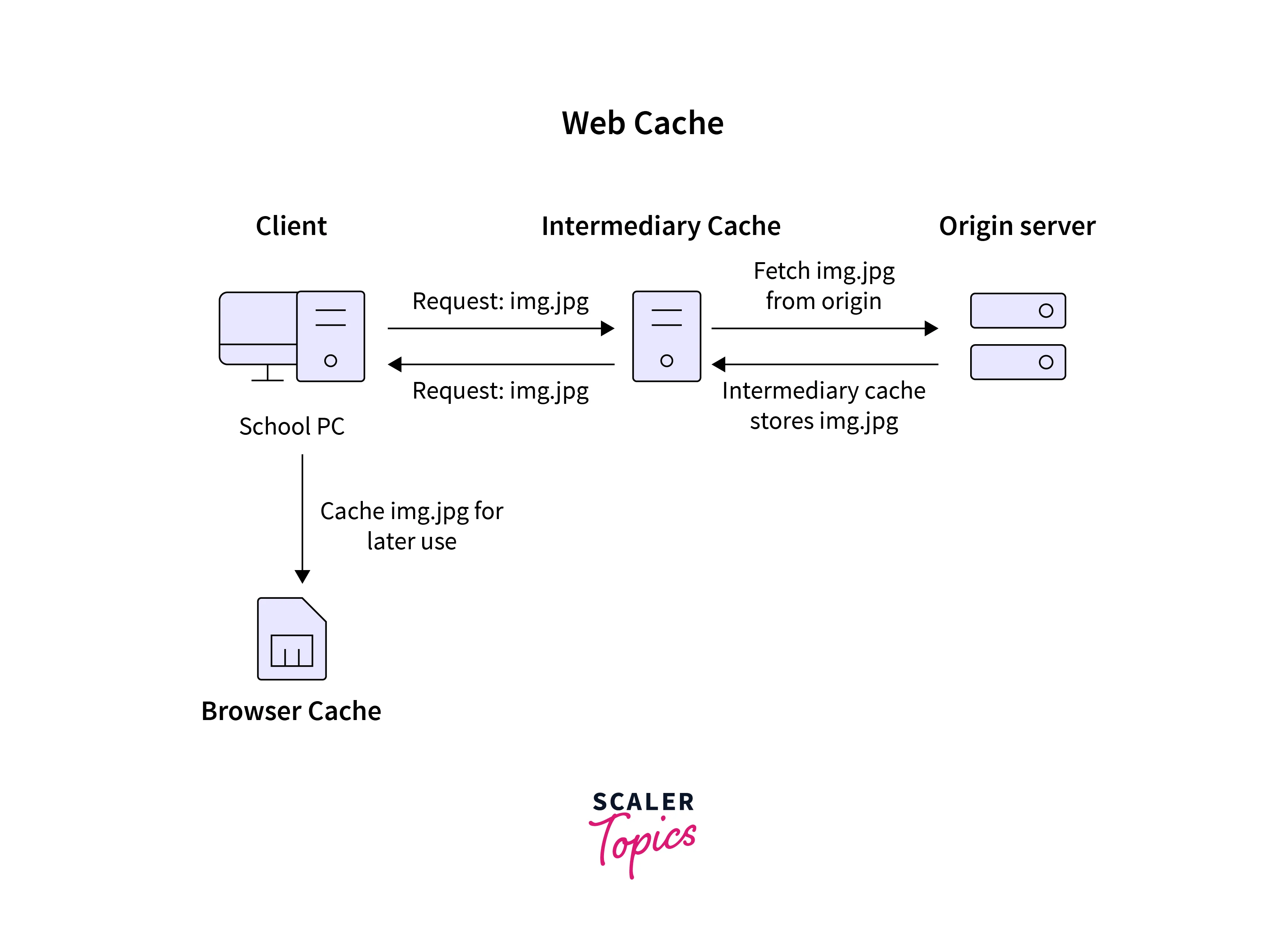The proxy server is the gateway that acts as an intermediary server between the user and the internet and entry of cyber attackers is prevented by it.
Web caching reduces the workload of the server by serving some of the requests of the web browser with the help of data stored in the cache.
Scope
- In this article, we will study the introduction of
proxy serversand web caching - We will also look at the working and the benefits of the proxy servers and web caching.
- At last we will cover the difference between proxy servers and web caching.
What are Proxy Servers?
The proxy server is generally used to work as a Gateway between the internet and the user. We can define a proxy server as an intermediary server as it separates the end users from the different websites they browse according to their requirements. We use these servers as it gives many levels of security, privacy and functionality according to the user requirements or policies of the organization.
Whenever we use a proxy server then the internet traffic flows only through the proxy server in the path to reach the address requested by the user. This particular request returns with the same proxy server. After this process, the proxy server forwards the requested data provided by the website to the user.
A proxy server can be defined as a system or a router that acts as a Gateway between the internet and the users. It helps in preventing the entry of cyber attackers into a private network. It is also defined by another term i.e, an intermediate server as it is present between the number of users and the websites visited by them.
How a Proxy Works?
Refer to the below image for the working of the proxy.

It is mandatory for every computer present on the internet to have its unique internet protocol (IP) address. Consider an IP address as a residential address of a system. As the post office needs your residential address to send your parcel, the internet also needs to know the IP address so that the data reaches its intended destination.
A proxy server is just like a computer on the internet that has its IP address and your computer is familiar with that IP address. Whenever the web Request is sent by the user, it first reaches the proxy server. After it, the proxy server provides the web Request to the intended web server on the behalf of that particular server. Then, forward the web page received from the server to the user so that the user can visit the web page in the browser.
When the web request is forwarded by the proxy server to the user then the proxy server can make some changes to the data sent by it. Instead of changes, the user receives the same information that they wanted to see. Proxy servers can hide the IP address of the user so that the web server never finds out the location of the particular user. It can also transmit the data in encrypted form so that it cannot be read by anyone else. It is allowed to deny access to some web pages depending on the IP address.
Benefits of a Proxy Server
Security
The proxy server provides enhanced security as it acts as a firewall between your device and the internet. An IP address can be easily accessed by hackers if a proxy server is not used.
Private Browsing
Incognito browsing also uses a proxy server by which searched history will be and any cookie is not stored in the computer.
Employees are Prevented from Browsing Distracting/Inappropriate Site
Access to those websites that are running in the opposite direction of your organization can be blocked by it. To increase the productivity of the organization, the websites that are distracting employees from their important tasks can be blocked. For avoiding time-wasting temptations, social networking sites like Facebook can also be blocked by the organization.
Data Logging:
Data logging refers to the process of storing and collecting data for activity analysis and future predictions. And proxy server allows data logging by storing the IP address of the user with the data of the web request.
What is Web Caching?
Storing the data to reuse it whenever it is required again is known as web caching similar to how a web server serves a web page to a browser.
When the user first visits the page then that page will be stored/cached and when the user visits the next page and requests for the same page then that copy of the web page is served from the cache, which also helps in reducing the overload of the origin server.
The delivery speed of the page is improved by the strategies and solutions of web caching. As a result, the backend server work is also reduced.
For ensuring that the freshest content is available in the cache, at specific time intervals caching servers are set to be refreshed and caching servers are also refreshed in response to some specific events.
How a Web Caching Work?
Refer to the below image for the working of the web caching

Your website resource copy is stored at a different place which is known as a web cache.
Web cache acts as an intermediate on the web. And the job of the web cache is to sit in between the user and the origin server and it also saves the HTTP responses sent by the server such as HTML documents, CSS files, images, videos, etc.
Web-cached responses are referred to as representations since the original website is represented by them at a particular point in time.
Requests sent by the browser for the resources are tracked by the web caches and then it serves them to the client. So that’s why for every request it is not required to go to the origin server.
If the requested resource is accessed from the cache then we call it cache hit.
On the other hand, if the requested resource is not accessed from the cache means the cache is not able to fulfil the request of the resource then we call it a cache miss.
Mostly in every case, we want that there is a high cache hit ratio, high cache hit ratio means most HTTP requests are retrieved from the cache and fulfilled by the cache.
Benefits of a Web Caching
Reduction in Consumption of Bandwidth
As web caching reduces the traffic on the network and decreases the congestion on the network that’s why bandwidth is reduced.
Server Workload Reduced
The workload of the web server is reduced as the data is spread widely and stored in the proxy caches.
Network Traffic Reduced
Since we don’t need to fetch all the data from the server, we can fetch frequently accessed data from the cache, which reduces network traffic as every request won’t go to the server.
Reduction in the Transmission Delay
Web caching reduces the transmission delay as documents that are accessed frequently are retrieved from the nearby cache so we are not required to fetch frequently accessed documents from the remote data servers.
Proxy Servers Vs Web Caching
The proxy server will behave as an intermediate between the server and the client and caching server is the proxy server sub-type.Transaction between the two is handled by the proxy server and web caching stores the data locally which is accessed from the WAN so that we do not require to go to the WAN next time and content is accessed from the cache.
Conclusion
- The proxy server is generally used to work as a Gateway between the internet and the user. The proxy server is used as an intermediary server as it separates the end users from the different websites they browse according to their requirements.
- Security and private browsing are some of the advantages of the proxy server.
- Storing the data to reuse it is known as
web cachinglike a web server served web page is stored. - When the user first visits the page then that page will be stored/cached and when the user visits the next page and requests for the same page then that copy of the web page is served from the cache, which also helps in reducing the overload of the origin server.
- Reduced Server workload, reduced network traffic, and reduced bandwidth consumption are the advantages of web caching.